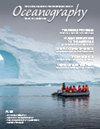挑战者深海内爆:冲击波的回声探测
IF 2.8
4区 地球科学
Q1 OCEANOGRAPHY
引用次数: 1
摘要
自1875年英国皇家海军挑战者号首次在马里亚纳海沟探空以来,科学家和探险家一直在寻求确定海洋最深处的确切位置和深度。科学界的共识是,最深的深度位于挑战者深海,这是马里亚纳海沟中的一个深渊,深度超过10000米。自1952年英国皇家海军挑战者二号(HMS Challenger II)返回马里亚纳海沟以来,已经对挑战者深海的深度进行了20次估计(包括本研究中的估计)。位置和深度估计与用于获得它们的方法一样多样化;它们的范围从早期的爆炸物和秒表测量,到单波束和多波束声纳,再到载人和远程操作的潜水器。2014年12月,我们乘坐施密特海洋研究所的R/V Falkor号船参加了挑战者深海探险,部署了两个自由落体被动声学仪器平台,每个平台都有一个玻璃球压力外壳,里面装有系统电子设备。在9000米的标称深度,其中一个外壳内爆,产生高能冲击波,正如另一台仪器记录的那样,该冲击波从海面和海底多次反射。根据这些多径脉冲到达幸存仪器的时间,结合水柱中声速剖面的同时测量,我们获得了挑战者深海的高度受限声学估计:10983±6 m。本文章由计算机程序翻译,如有差异,请以英文原文为准。
Implosion in the Challenger Deep: Echo Sounding with the Shock Wave
Since HMS Challenger made the first sounding in the Mariana Trench in 1875, scientists and explorers have been seeking to establish the exact location and depth of the deepest part of the ocean. The scientific consensus is that the deepest depth is situated in the Challenger Deep, an abyss in the Mariana Trench with depths greater than 10,000 m. Since1952, when HMS Challenger II, following its namesake, returned to the Mariana Trench, 20 estimates (including the one from this study) of the depth of the Challenger Deep have been made. The location and depth estimates are as diverse as the methods used to obtain them; they range from early measurements with explosives and stop watches, to single- and multi-beam sonars, to submersibles, both crewed and remotely operated. In December 2014, we participated in an expedition to the Challenger Deep onboard Schmidt Ocean Institute’s R/V Falkor and deployed two free-falling, passive-acoustic instrument platforms, each with a glass-sphere pressure housing containing system electronics. At a nominal depth of 9,000 m, one of these housings imploded, creating a highly energetic shock wave that, as recorded by the other instrument, reflected multiple times from the sea surface and seafloor. From the arrival times of these multi-path pulses at the surviving instrument, in conjunction with a concurrent measurement of the sound speed profile in the water column, we obtained a highly constrained acoustic estimate of the Challenger Deep: 10,983 ± 6 m.
求助全文
通过发布文献求助,成功后即可免费获取论文全文。
去求助
来源期刊

Oceanography
地学-海洋学
CiteScore
6.10
自引率
3.60%
发文量
39
审稿时长
6-12 weeks
期刊介绍:
First published in July 1988, Oceanography is the official magazine of The Oceanography Society. It contains peer-reviewed articles that chronicle all aspects of ocean science and its applications. In addition, Oceanography solicits and publishes news and information, meeting reports, hands-on laboratory exercises, career profiles, book reviews, and shorter, editor-reviewed articles that address public policy and education and how they are affected by science and technology. We encourage submission of short papers to the Breaking Waves section that describe novel approaches to multidisciplinary problems in ocean science.
 求助内容:
求助内容: 应助结果提醒方式:
应助结果提醒方式:


